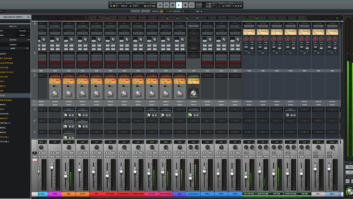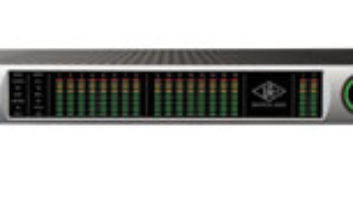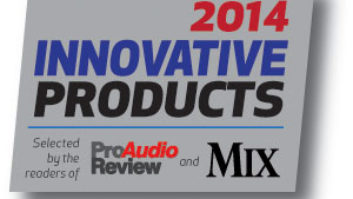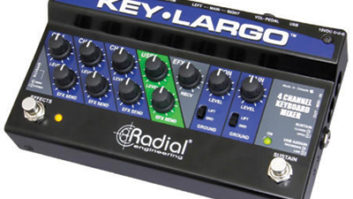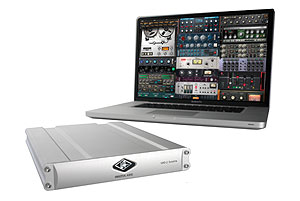
The UAD-2 Satellite comes in 2- or 4-chip versions.
The UAD-2 Satellite comes in 2- or 4-chip versions.
The ranks of external hardware plug-in accelerators have thinned since SSL went Native-only with its Duende plug-ins in February 2011 and Waves stopped making its APA32 and APA44 units. Still, Universal Audio has been chugging away, developing a wide array of options for those wanting access to its UAD-2 plug-ins, which are only accessible on the company’s proprietary hardware. Universal Audio’s latest effort in this regard was released at NAMM in January 2011 as part of the UAD-2 Satellite Duo and Quad accelerators. The Quad unit is under the microscope in this review, which I ran on a Mac 2.26MHz Intel Core 2 Duo 13-inch laptop with 4 GB of RAM running Mac OS 10.6.7.

The UAD Link light shows connection status and sits with two FW800 and one FW400 ports on the back of the unit.
What’s new about the Satellite platform is the ability to open up the UAD-2 plugs to FireWire 800- and 400-equipped Intel-based iMacs, MacBook Pros and Mac minis. The units are powered by two or four SHARC processors, allowing a whole new group of desktop users access to a large range of processors without taxing internal RAM, which then can be used for other plug-ins outside the UAD-2 family.
START ME UP!
With purchase, you get the UAD-2 Satellite enclosure, which looks very much like an external hard drive, and the Analog Classics plug-in bundle offering the LA-2A and 1176LN/SE compressors, Pultec EQP-1A EQ and RealVerb Pro plug-ins. The unit works with a range of DAWs with support for AU, VST and RTAS formats. From there, you can use the included $50 voucher to purchase new plug-ins from the sizable UAD library.
Out of the box, the UAD-2 couldn’t be easier to hook up. Just FireWire into your host computer, and you’re ready download your plug-ins and host software from the included disc, and then authorize your system via Universal Audio’s Website.
The UAD Meter and Control Panel is one of the system’s best features. It offers a wealth of valuable info to configure your system, check your resources, keep track of your plug-in licenses and get help if needed. Under the System Info tab, you can view your Satellite hardware and see the DSP percentage used per chip, the amount of latency, current software version, check for updates and more. The Plug-Ins tab is where all your licenses are listed, while the Configuration tab gives you access to some high-level tweaks for setting up your DAW. The Help screen offers a UAD Registration and Authorization FAQ, UAD voucher and Plug-In Purchase FAQ, a user manual, the ability to contact support via email, a link to the Support page, access to your my.audio account and a UA Webzine.
Even when the info gets deep, you can get a high-level heads-up by rolling over each section, which reveals a complete explanation of the feature in the INFO box at the bottom of the window. I used this feature with Pro Tools more than once when I needed to fine-tune my system.

THE SOUNDS
I can’t possibly get into each available plug-in in UAD-2 land, so I’m going to touch on the high points of my experience here. I happened to be mixing a daunting 80-plus-track song at the time and quickly ate up a lot of processing. For compression and general track warming, I fell in love with the Fatso Jr. The interface can be confusing at first, but a quick trip to Empirical Labs’ Website got my head around it quickly. It is very good at adding degrees of warmth to challenged tracks. In this case, I had a poorly recorded sax track that also happened to be the lead instrument in my mix. I used the Fatso just for warmth and then the Fairchild 670 emulation to tame the transients and bring it nicely into the mix.
I had equally good results with the Trident A-Range EQ, dbx 160 compressor and EMT reverbs on a variety of instruments. The EMT 140 plate quickly became one of my favorites. I was able to download the UAD 5.9 software update just before penning this review and had a chance to play with the new Lexicon 224 reverb. It is excellent, and there are some great presets written by top engineers who have used the 224 for many years. This brings up the point I love most about the UAD-2 hardware emulations: The company is not afraid to make it a challenge to use the processors; these aren’t dumbed-down versions. You can go as deep as you want on your own, which is exactly like the hardware. A one-knob world is a boring world. However, if you want a good starting point, there are great presets for every plug-in to help you get your feet wet. One size fits every user, advanced or not.
The only problem I had when using the system is an occasional disconnect between Pro Tools and the UAD-2 Satellite. Diagnosis is easy using the Link LED placed—unfortunately on the back of the unit. I was sharing the FW800 bus with a hard drive so that could have been part of the issue. Nonetheless, it was easy to fix by pulling and re-seating the FireWire cable to the Satellite.
I’M IN ORBIT
Using Satellite Quad was nothing short of an epiphany with regard to what can be mixed natively on a laptop. If you’ve ever tried to survive with internal RAM alone, you quickly realize it’s a dead end; you need TDM or one of the existing UAD cards in your tower to pull it off.
Before Satellite, the best you could get is the Solo/Laptop card (one chip) on a 17-inch Mac laptop. Now you can get up to four chips on any FireWire-capable, Intel-based Mac laptop, iMac, MacBook Pro or Mac mini. This is an exponential bonus in power and flexibility.
And I haven’t even touched on how great the plug-ins sound. Los Angeles–based engineer David Rideau put it best when I told him how excited I was about the UAD-2 processors. He said, “Even if I bring up a plug-in and it’s not what I’m looking for, they still sound great.” He’s right. The range of hardware emulations are broad, intelligently presented with accurate GUIs and just the right amount of upgrades to take it into the digital realm. If you want to extend your creative reach and make yourself a better mixer, especially on a laptop, UAD-2 Satellite is your next best step.
Kevin Becka is
Mix
’s technical editor.

Click on the Product Summary box above to view the UAD-2 Satellite product page.
